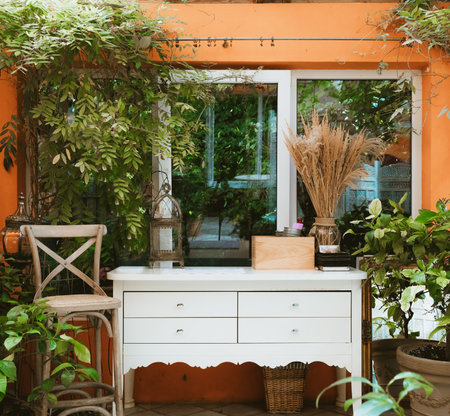Understanding the British Conservatory-Garden Connection
In the UK, the conservatory has long held a special place in the hearts of homeowners, serving as a cherished link between indoor comfort and the beauty of the natural world outside. Historically, British conservatories were more than just sunlit rooms; they were elegant glass structures designed to nurture exotic plants and provide a tranquil retreat for afternoon tea or quiet contemplation. Over time, these spaces evolved from Victorian symbols of status into practical living areas that extend the enjoyment of one’s home throughout the year. Today, blending your conservatory seamlessly with your outdoor garden is regarded not only as a design aspiration but also as a beloved tradition that celebrates our enduring appreciation for nature. By thoughtfully integrating these two spaces, you create a harmonious transition that invites greenery, fresh air, and seasonal changes directly into your daily life—a truly British approach to making the most of both your home and garden.
Choosing the Right Materials and Colours
When aiming to create a seamless flow between your conservatory and garden, selecting appropriate materials and colours is paramount. The right choices not only enhance visual harmony but also help bridge the gap between indoor comfort and outdoor splendour, echoing classic British outdoor aesthetics.
Traditional vs Modern Materials
Consider using traditional British materials such as timber, stone, or brick for your conservatory’s framework. These materials naturally complement the textures often found in UK gardens, such as dry-stone walls or weathered wooden fences. For those preferring a modern twist, aluminium and composite frames offer durability while still providing clean lines that do not clash with natural surroundings. Below is a comparison table to guide your selection:
| Material | Style | Main Benefits | Best Paired With |
|---|---|---|---|
| Timber | Traditional | Warmth, classic look, sustainable | Cottage gardens, mature planting |
| Stone/Brick | Traditional | Characterful, blends with historic homes | Walled gardens, heritage properties |
| Aluminium | Modern | Sleek, low-maintenance, slim frames | Contemporary landscapes, urban gardens |
| Composite | Modern/Transitional | Durable, variety of finishes, eco-friendly options | Diverse planting schemes, mixed-style homes |
Selecting Colour Palettes for Harmony
The palette you choose should reflect the hues already present in your outdoor space. In classic British gardens, muted greens, soft greys, off-whites, and earthy browns are prevalent. For a more contemporary effect without losing cohesion, consider charcoal or slate finishes that pick up on patio stones or fencing. If your home features red brick or sandstone, echo these tones within your conservatory’s framework or flooring to foster unity.
Top Colour Choices for Seamless Integration:
- Sage green – pairs beautifully with lawns and hedgerows.
- Creamy white – mirrors traditional window frames and enhances natural light.
- Pebble grey – complements gravel paths and modern patios.
- Terracotta – ties in with potted plants and rustic paving.
- Slate blue – offers a subtle nod to classic British weatherboards.
A Practical Tip:
If you’re unsure about which shade to use, step into your garden at different times of day and observe how light interacts with existing materials. This will help you select tones that naturally transition from inside out.
![]()
3. Optimising Layout for Flow and Accessibility
Creating a seamless connection between your conservatory and garden relies heavily on thoughtful layout design. Start by considering the direct pathways that link the two spaces. Opt for natural stone or gravel paths that gently guide you from the conservatory doors into the heart of your outdoor area, echoing the traditional British garden style while ensuring safe footing in all weathers.
When planning entrances, wide or bifold doors are ideal for maximising openness and accessibility. French doors can also add a charming, classic touch while offering ample space to move through with ease – perfect for carrying trays of tea or garden tools. Position these doors so they align with main garden walkways, allowing for an effortless transition between indoors and out.
Glazing plays a crucial role in creating visual and physical flow. Floor-to-ceiling glass panels not only flood your conservatory with natural light but also provide uninterrupted views of the greenery beyond. Consider using minimal framing to keep sightlines clear, making your indoor space feel like an extension of the outdoors even when the doors are closed. For added practicality, ensure thresholds are low-profile to accommodate prams, wheelchairs, or those less steady on their feet.
Think about how furniture placement can enhance movement. Arrange seating away from doorways to avoid bottlenecks and use lightweight pieces that can easily be repositioned for gatherings or quiet afternoons with a book. Incorporate storage solutions that tuck away gardening essentials without cluttering access points.
By thoughtfully arranging paths, selecting user-friendly doors, and choosing appropriate glazing, you’ll create an inviting, accessible route between your conservatory and garden – one that encourages you to enjoy both spaces throughout every season.
4. Incorporating British-Inspired Planting Schemes
Blending your conservatory with the surrounding garden is all about creating a harmonious transition between the indoors and outdoors. One of the most effective ways to achieve this is by embracing quintessentially British planting schemes, both inside your conservatory and immediately outside its doors. This approach not only reinforces a sense of continuity but also celebrates the distinct character of an English garden.
Choosing Iconic British Flora
Begin by selecting plant varieties that are synonymous with British gardens. Incorporate classic choices such as lavender, foxgloves, delphiniums, and roses for a timeless cottage-garden look. These plants can thrive both in pots inside your conservatory and in flowerbeds just beyond, establishing visual connections between both spaces.
Planting Scheme Ideas for Seamless Transitions
| Area | Recommended Plants | Design Tips |
|---|---|---|
| Inside Conservatory | Potted geraniums, ferns, trailing ivy, English lavender, scented pelargoniums | Group pots at varying heights; use rustic terracotta or classic stone planters for an authentic British touch. |
| Threshold/Transition Zone | Boxwood (Buxus) topiary, climbing roses, hydrangeas in planters | Place symmetrical planters on either side of doors; train climbers along frames to blur boundaries. |
| Immediately Outside Conservatory | Perennial borders with delphiniums, lupins, foxgloves, hostas; mixed shrubs like viburnum or mock orange (Philadelphus) | Create layered planting beds with taller blooms at the back and low-growing varieties at the front for depth and flow. |
Integrating Structure and Softness
British gardens are renowned for their mix of structure and informality. Use evergreens such as box or yew to frame entrances and provide year-round interest, while allowing loose drifts of herbaceous perennials and seasonal bulbs to soften the edges. This balanced blend mirrors the naturalistic yet curated feel typical of UK gardens.
Scented Pathways and Wildlife-Friendly Choices
Enhance your indoor-outdoor experience by planting fragrant herbs like thyme or rosemary near paths and seating areas. Not only do these evoke traditional British scents, but they also attract pollinators—supporting local wildlife and giving your conservatory garden a lively, ever-changing atmosphere.
5. Blurring Boundaries with Design Features
One of the most effective ways to achieve a seamless transition between your conservatory and garden is by thoughtfully incorporating design features that blur the lines between indoors and out. Consider these practical suggestions to dissolve both physical and visual barriers:
Patios and Decking: Creating Flow
Installing a patio or timber decking directly adjacent to your conservatory can create a sense of continuity, especially if you match or complement the flooring materials. Opt for natural stone paving, brick, or composite decking in tones that echo your interior flooring. Flush thresholds and wide, folding doors further enhance this flow, encouraging an effortless step from inside to outside—a hallmark of British garden living.
Lighting: Extending Ambience Beyond Walls
Strategically placed outdoor lighting not only makes your garden usable after dusk but also visually extends your living space. Use soft LED uplighters along pathways, festoon lights strung over seating areas, or lanterns on patio tables. Consider continuing your conservatory’s lighting scheme outdoors for a harmonious effect; warm white bulbs will evoke a welcoming glow even on cooler evenings.
Soft Furnishings: Indoor Comfort Outdoors
Bring the comfort of your conservatory into the garden with weather-resistant cushions, throws, and rugs in complementary colours or patterns. Rattan furniture sets with plush upholstery work beautifully both inside and out, especially when accented with botanical prints or pastel shades reminiscent of an English country garden. Stow extra textiles in waterproof storage benches so they’re always close to hand when the sun appears.
Unifying Elements: A Cohesive Palette
To truly dissolve boundaries, select a cohesive palette that runs from your conservatory through to your patio or deck and into the surrounding beds. Echo accent colours in plant pots, outdoor artwork, or even painted fence panels. This subtle repetition draws the eye naturally from one zone to another.
Conclusion
By carefully integrating patios, decking, lighting, and soft furnishings with a unified design approach, you can create a living space where it’s difficult to tell where home ends and garden begins—a true celebration of British indoor-outdoor living.
6. Highlighting Seasonal Enjoyment
One of the true joys of a well-integrated conservatory and garden is the ability to enjoy both spaces throughout the changing British seasons. With our famously unpredictable weather, it pays to plan for year-round comfort and visual appeal.
Make the Most of Every Season
Start by selecting plants and garden features that offer interest in every season. Opt for evergreens, winter-flowering shrubs like witch hazel or mahonia, and bulbs such as snowdrops and daffodils that herald the arrival of spring. Position these close to your conservatory so you can appreciate them from inside, even on chilly days.
Create Weather-Resistant Comfort
Invest in durable, weatherproof furniture and outdoor rugs for your conservatory’s transition zone. This ensures the space remains inviting whether you’re seeking shade on a hot summer afternoon or shelter from a sudden downpour. Consider installing underfloor heating or portable heaters, making your conservatory a cosy retreat during colder months without sacrificing style or connection to the outdoors.
Lighting for All Occasions
Enhance the atmosphere with thoughtfully placed lighting—soft fairy lights, lanterns, or solar-powered path lights can extend enjoyment into dusk and beyond, whatever the time of year. This not only adds ambience but also maintains a visual link between your indoor and outdoor spaces when daylight fades.
Flexible Design Solutions
Use folding or sliding doors to open up your conservatory fully in fair weather, blurring the boundary between indoors and out. In less clement conditions, quality glazing allows you to admire your garden’s beauty while staying snug indoors—a particularly valuable feature during those long British winters.
By embracing solutions tailored to the UK climate, you ensure your conservatory-garden connection is one to be relished in every season—rain or shine—making your home truly adaptable and always ready for enjoyment.

